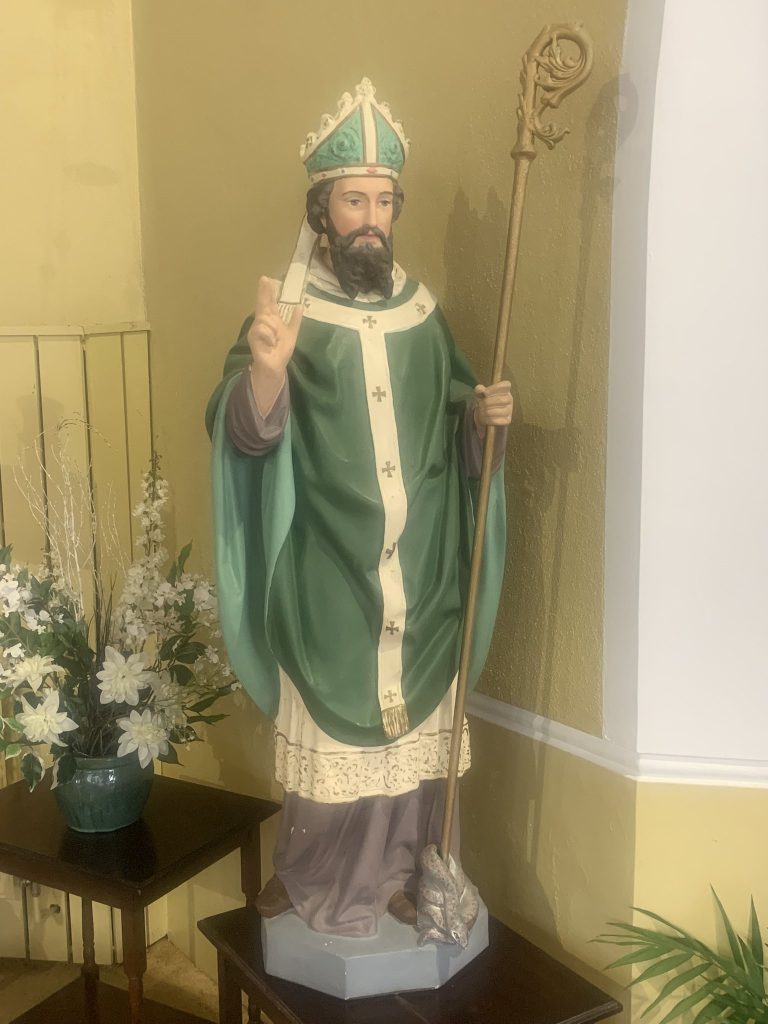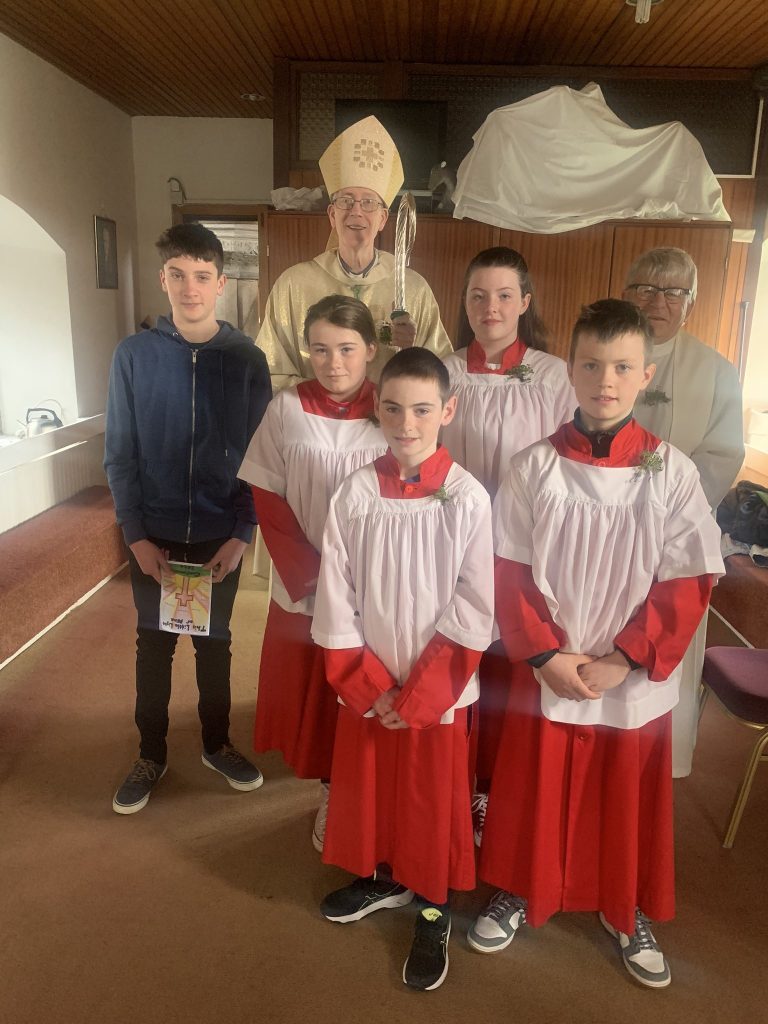St. Patrick’s Day – Year B: 17.03.23
St. Patrick’s Church, Rathoe @ 10am
Introduction:
Beannachtaí na Féile Pádraig oraibh go léir! A very happy & blessed St. Patrick’s Day to all of you this holyday morning. I am delighted to be here with Fr. Jim and all of you to celebrate Mass in Rathoe, in one of our nine churches dedicated to St. Patrick.
Patrick’s first visit to Ireland was at the age of 16, a young slave, taken captive, and like the young prodigal, he might have eaten the husks the sheep were been fed on, but no one offered him anything. Thirty years later at 47 years of age, he would make his second visit as a Bishop, responding to hearing “the voice of the Irish”.
Was Patrick responsible for formally establishing the Church in Ireland? It’s difficult to tell. Did he throw the snakes out of Ireland? We’ll never know. So much of Patrick’s story is legendary and often conflicting.
The Synodal Pathway we are on is one of communion, participation and mission. St. Patrick’s life and witness retains the potential to breathe fresh impetus into our missionary efforts today. And so as we prepare to celebrate these sacred mysteries on Lá Féile Pádraig, we pray …
• Is tusa Tobar na Trócaire—you are the wellspring of mercy: A Thiarna, déan trócaire.
• Is tusa Slí na Fírinne—You are the way of Truth: A Chríost, déan trócaire.
• Bí linn i gconaí, ós ár gcomhair amach—Be with us always, showing us the way. A Thiarna, déan trócaire.
Homily:
Patrick in his ‘Confessio’ teaches us that God is One. This was an important message in a world, a land, a culture where many gods were worshipped. The shamrock, gives us the glimpse and understanding of the triune God – a communion of three persons in One. In the Old Testament there was worship of golden calves, when the people felt God had deserted them. In today’s world we too quickly supplement false gods once again. Material possessions, needing to have the latest fad, accessing everything on an app, at our fingertips.
And why, because everyone else seems to be doing it, everyone else has it, no one dares to stand apart. Patrick was one person who chose to stand apart. Alone on the Hill of Slane lighting a flame to outshine the pagan flame of Tara
The notion of a Bank Holiday to honour Patrick was introduced in 1903, 120 years ahead of the one to honour St. Brigid, introduced last year. 1903 was also the year of the first St. Patrick’s Day parade in Ireland in Waterford. In eight years’ time, in 2032, we will be honouring the 1600th anniversary of Patrick’s coming to Ireland in 432AD. It is said that Brigid and Patrick are both buried at Downpatrick. And while we always pray that our deceased rest in peace, we might disturb them a little to ponder what lesson might they have for the Ireland of today?
While Patrick has left behind some writings, there are many things associated with the saint that have little authenticity. How many accounts dare to suggest Patrick lit the fire on Tara Hill. He didn’t, he couldn’t, King Laoghaire was there. It was very much lit in Slane and the focus there is on two elements, the fire and the shamrock.
The Fire, symbolic of the undimmed light of Christ, what we will do at the great Easter Vigils in all our parishes is an imitiation of St. Patrick, reminding us our flame still flickers, despite the attempts by many to quench it. Fire is very powerful, it can destroy but it can also refertilise. A single flame-point illuminates darkness, mesmerises the eye, offers a focus.
And then the shamrock. The Irish word for shamrock is seamróg which is the dimunitive of the Irish word for clover – seamair, meaning simply little clover or young clover. Many will wear clover today, thinking it’s shamrock, but we know clover can be four leafed. Hands up those wearing shamrock today? The shamrock always has three unblemished green leaves and its that which offered Patrick a catechetical tool. Sometimes we miss the images around us; sometimes we miss what is staring us in the face. Patrick didn’t and we shouldn’t either.
The Greeks in the gospel ask to see Jesus. Patrick came to Ireland, so that the Irish might see Jesus. In our gospel Jesus opens up and shares some of the fears and hopes in his own heart. Patrick, unlike so many of our saints has left behind us two important testimonies: the Confessio and his Letter to Coroticus and His Soldiers. Both of them share something of the fears and hopes in his heart. Both begin with an acknowledgement that he is a sinner. His Confessio begins: “I Patrick, am a sinner, the most uncultured and smallest among all the faithful, indeed many people consider me to be worthless” . He begins the ‘Letter to Coroticus and His Soldiers’ in a similar vein: “I, Patrick, an unlearned sinner who dwells in Ireland, profess that I am a Bishop. I am sure that it is God who has made me what I am” . Patrick may have been down playing his own worthiness, but he certainly was scarred by a sin he had committed in his youth, a sin that would come back to bite him in later years.
Maybe we sometimes find it hard to comprehend that our faith was brought to us by a sinner who became a saint. It’s not easy to accept that the messenger can be flawed. Pope Francis was elected Pope eleven years ago last Wednesday. The first Mass he celebrated with the faithful was on St. Patrick’s Day 2013 in the parish church of St. Anna in Rome, where he chose to speak of mercy, using the example of a man who told him he had done some terrible things, to which the Pope responded: “Go to Jesus, he forgives and forgets everything” . His message was God never tires of forgiving.
And I suggest this is the message we must take away from the life of our St. Patrick and we are also encouraged, as sinners, to hand on the faith, sometimes we may be “briste agus bruite”, broken and crushed, and like Patrick, we may feel worthless, but we all have a part to play.
It saddened me and hopefully you last evening, to watch the main news headline coming from Ireland on the eve of St. Patrick’s Day was the image of tents being clawed off Mount Street in Dublin, emigrants being bused off to some place out of sight, out of mind. Over €20M was spent, some might say wasted, on referendums that achieved nothing a few days ago; we need to have a mature, open and honest conversation about migration. Patrick came as a migrant. An Ireland of welcomes isn’t something that tolerates racism or holds up an iPhone in front of migrants faces filming their every move. May we like St. Patrick “arise today through God’s strength to pilot me, God’s wisdom to guide me, God’s way to lie before me” .
Beannachtaí na Féile Padraig oraibh go leir.

